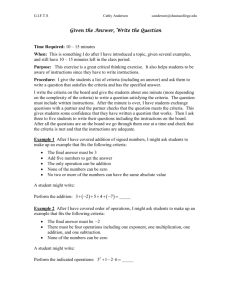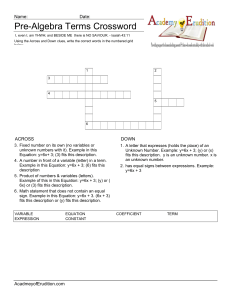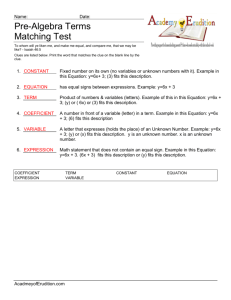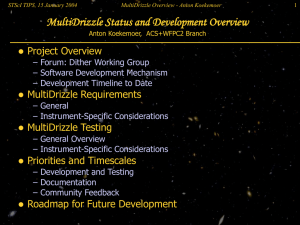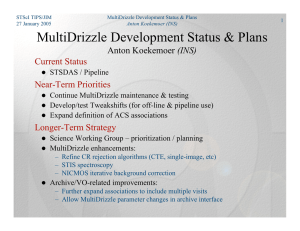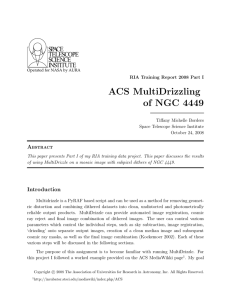WFPC2 Advisory: Incorrect PHOTFLAM header keyword value in Multidrizzle output images.
advertisement
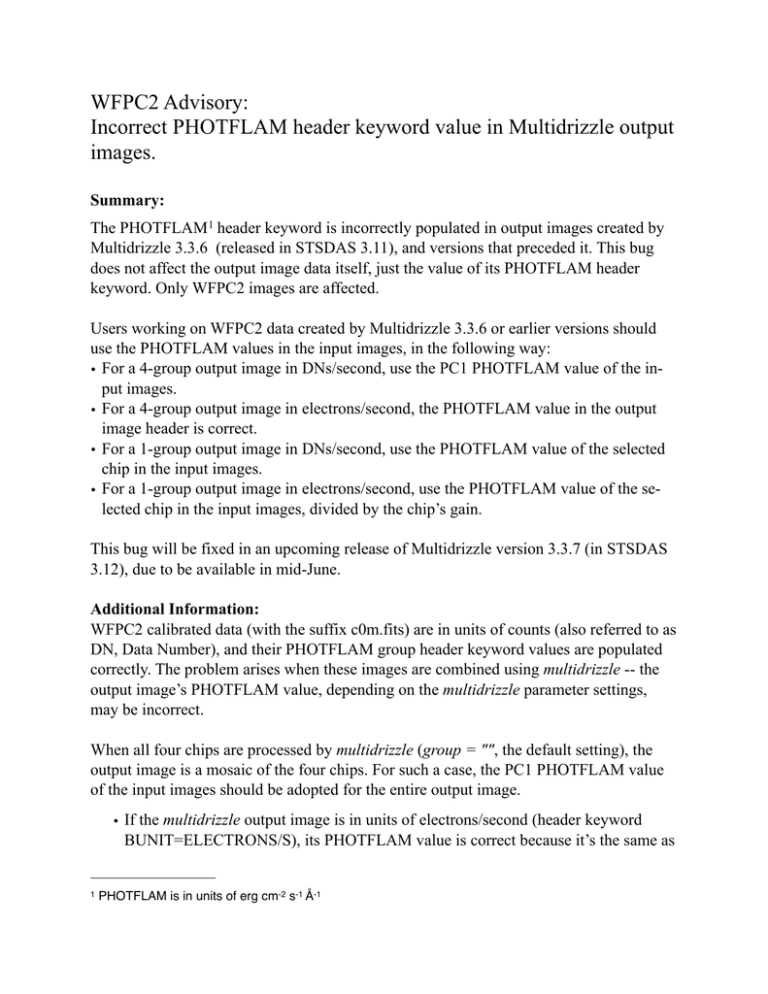
WFPC2 Advisory: Incorrect PHOTFLAM header keyword value in Multidrizzle output images. Summary: The PHOTFLAM 1 header keyword is incorrectly populated in output images created by Multidrizzle 3.3.6 (released in STSDAS 3.11), and versions that preceded it. This bug does not affect the output image data itself, just the value of its PHOTFLAM header keyword. Only WFPC2 images are affected. Users working on WFPC2 data created by Multidrizzle 3.3.6 or earlier versions should use the PHOTFLAM values in the input images, in the following way: • For a 4-group output image in DNs/second, use the PC1 PHOTFLAM value of the input images. • For a 4-group output image in electrons/second, the PHOTFLAM value in the output image header is correct. • For a 1-group output image in DNs/second, use the PHOTFLAM value of the selected chip in the input images. • For a 1-group output image in electrons/second, use the PHOTFLAM value of the selected chip in the input images, divided by the chip’s gain. This bug will be fixed in an upcoming release of Multidrizzle version 3.3.7 (in STSDAS 3.12), due to be available in mid-June. Additional Information: WFPC2 calibrated data (with the suffix c0m.fits) are in units of counts (also referred to as DN, Data Number), and their PHOTFLAM group header keyword values are populated correctly. The problem arises when these images are combined using multidrizzle -- the output image’s PHOTFLAM value, depending on the multidrizzle parameter settings, may be incorrect. When all four chips are processed by multidrizzle (group = "", the default setting), the output image is a mosaic of the four chips. For such a case, the PC1 PHOTFLAM value of the input images should be adopted for the entire output image. • If the multidrizzle output image is in units of electrons/second (header keyword BUNIT=ELECTRONS/S), its PHOTFLAM value is correct because it’s the same as 1 PHOTFLAM is in units of erg cm-2 s-1 Å-1 the input images PC1 PHOTFLAM value (for data in DN) converted for data in electrons. For example, datasets ubaa050[3,4,7,8]m_c0m.fits, with data in units of DN, have the following PC1 PHOTFLAM values --> hsel *c0m.fits[1] $I,photflam yes ubaa0503m_c0m.fits[1] 8.356935E-18 ubaa0504m_c0m.fits[1] 8.356935E-18 ubaa0507m_c0m.fits[1] 8.356935E-18 ubaa0508m_c0m.fits[1] 8.356935E-18 If multidrizzle is run on these datasets with proc_unit=electrons and group="" (the default settings), the output PHOTFLAM value is: --> hselect all_eps_drz.fits[1] photflam,bunit yes 1.173726825842697E-18 ELECTRONS/S This is the same as the input images PC1 PHOTFLAM value (for data in DN), rescaled for data in electrons by dividing it with the PC1 gain 7 value: 8.356935E-18 / 7.12 =1.1737268258426967e-18 The PC1 gain 7 value, 7.12, was obtained from Table 4.2 of the WFPC2 Instrument Handbook for Cycle 17, http://www.stsci.edu/hst/wfpc2/documents/handbook/cycle17/ch4_ccd5.html#474063 . • If the multidrizzle output image is in DNs/second (header keyword BUNIT=COUNTS/S), the PHOTFLAM header keyword is incorrectly populated with a value meant for data in electrons/second. For such cases, the PC1 PHOTFLAM value of the input images should be used as the PHOTFLAM value of the multidrizzle output image (this is equivalent to multiplying the incorrect PHOTFLAM value with the PC1 gain value). Continuing from the example above, if multidrizzle is run on the datasets with proc_unit=native and group="", it's output image PHOTFLAM value is --> hselect all_cps_drz.fits[1] photflam,bunit yes 1.173726825842697E-18 COUNTS/S As illustrated earlier, this value is for data in electrons. The correct value should be the input images PC1 PHOTFLAM value, 8.356935E-18, for data in DN. When only one chip is processed by multidrizzle (ie. group=3), the PHOTFLAM of the input images’ selected chip should be adopted by the output image. However, multidrizzle is not implementing this correctly; regardless of which chip and output data unit are se- lected, the output image’s PHOTFLAM value is always the input images PC1 PHOTFLAM value. • If the multidrizzle output image is in DNs/second (header keyword BUNIT=COUNTS/S), the input images PHOTFLAM value, for the selected chip, should be used. For example, datasets ubaa050[3,4,7,8]m_c0m.fits[3], with data in units of DN, have the following WF3 PHOTFLAM values --> hsel *c0m.fits[3] $I,photflam yes ubaa0503m_c0m.fits[3] 7.770833E-18 ubaa0504m_c0m.fits[3] 7.770833E-18 ubaa0507m_c0m.fits[3] 7.770833E-18 ubaa0508m_c0m.fits[3] 7.770833E-18 If these datasets are multidrizzled with parameters proc_unit=native and group=3, the output image’s PHOTFLAM value is incorrectly populated with the input images PC1 PHOTFLAM value: --> hsel wf3_cps_drz.fits[1] photflam,bunit yes 8.356935E-18 COUNTS/S It should be the same as the WF3 PHOTFLAM value of the input images, 7.770833E-18. • If the multidrizzle output image is in units of electrons/second (header keyword BUNIT=ELECTRONS/S), the input images PHOTFLAM value, for the selected chip, divided by the chip’s gain, should be the output image’s PHOTFLAM value. Continuing from the example above, if the datasets are multidrizzled with parameters proc_unit=electrons and group=3, the output image’s PHOTFLAM value is incorrect: --> hsel wf3_eps_drz.fits[1] photflam,bunit yes 8.356935E-18 COUNTS/S It should be the same as the input images WF3 PHOTFLAM value, scaled by division with the selected chip’s gain value. 7.770833E-18 / 6.90 = 1.126208e-18 The scaling factor for WF3 gain 7, 6.90, was obtained from Table 4.2 of the WFPC2 Instrument Handbook for Cycle 17, http://www.stsci.edu/hst/wfpc2/documents/handbook/cycle17/ch4_ccd5.html#474063 )
